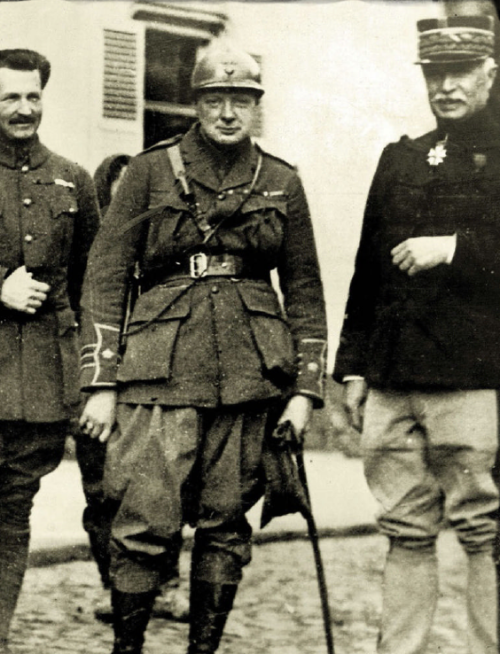CHURCHILL’S 1911
In May 1915, following the failure of the Allied landings at Gallipoli, Winston Churchill the First Lord of the Admiralty and one of the architects of the landings was sacked. In November he returned to the army, he had graduated from Sandhurst in 1894 and had seen active service in India, Sudan and South Africa. Since 1902 he had been a reserve officer, a major in the yeomanry regiment the Queen’s Own Oxfordshire Hussars. On the 20th November, Churchill was attached to the 2nd Battalion Grenadier Guards to gain experience at the front and to prepare him for command of a brigade.
In December 1915, the Grenadier Guards rotated out of the frontline and Churchill toured nearby French sectors where he was gifted a steel Adrian helmet. Churchill wore this for the rest of his time on active service. The brigade Churchill had hoped for never materialised with Field Marshall Sir Douglas Haig willing only to give Churchill command of a battalion.
On 1st January 1916, Churchill was promoted to lieutenant colonel and given command of the 6th Battalion, Royal Scots Fusiliers replacing Lieutenant Colonel Herbert Northey.
The battalion had taken heavy casualties at the Battle of Loos and was suffering from low morale when he took command. Initially struggling to gain the trust of his officers and men, in part due to his cavalry training he quickly learnt the necessary commands for infantry and learnt how to use all the weapons the battalion was issued with.
During this time Churchill armed himself with a privately purchased American Colt Government Model (or Model 1911) with a specially made custom holster to fit his Sam Browne belt (see image #3). Bought in London, with London proof markings, Churchill had his name engraved onto the right side of the slide.
It is unclear if the pistol was bought by himself or he was given it as a gift. However, he liked the pistol and certainly favoured it over the often carried Webley revolver approved by the army and carried by many officers.
As a wealthy man Churchill had always enjoyed being able to purchase the latest and best campaign equipment. While serving in the Sudan he had carried a Mauser C96 and while in France he had his own water heater brought to the front line and had his wife send him wading boots and a sheepskin lined sleeping bag.

Churchill wearing his French Adrian helmet and possibly armed with his Colt 1911 (source)
When the battalion returned to the frontline Churchill was in his element visiting the trenches three times a day and directing the improvement of his sectors trench fortifications. He frequently came under fire but was said to be calm and collected even when his command post was shelled.
While Churchill commanded the battalion the sector remained quiet and was not called upon to undertake offensive operations. In May 1916 the understrength 6th and 7th battalions of the Royal Scots Fusiliers were ordered to amalgamate with the 7th battalion’s commanding officers taking command. Churchill spent 108 days in command and took this opportunity to return to London and was appointed Minister of Munitions in July 1917.
Churchill himself later said: “I shall always regard this period when I have had the honour to command a battalion of this prestigious regiment (Royal Scots Fusiliers) in the field, as one of the most memorable in my life.”
Sources:
Churchill and War, G. Best (source)
Finest Hour “In The Field” – Churchill and Northey, B. Nanny (source)
Churchill During the Great War (source)
Colt Government Model (civilian, 1911) IWM, (source)
Churchill Rejoins the Ranks, Military History Oct. 2015, B.P. Tolppanen


